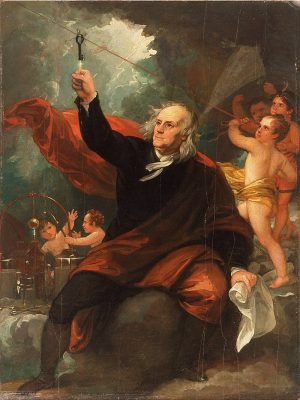Benjamin Franklin was born in Boston on January 17, 1706. His father, Josiah Franklin, was a tallow chandler who married twice—first to Anne Child and then to Abiah Folger. Benjamin was Abiah’s ninth child and Josiah’s fifteenth child. Young Benjamin showed an early aptitude for learning, and his father placed him in the Boston Grammar School at age eight. However, his formal schooling ended after just two years when his father pulled him out of school to work in the family business. He also continued to learn on his own, reading voraciously and teaching himself subjects such as math and science.
The Leyden Jar Experiment
Electricity, in particular, fascinated Franklin. In 1746, he heard about a German cleric and physicist named Ewald Georg von Kleist who had created a device called the Leyden jar—a glass jar that could store an electrical charge. Scientists in Europe began experimenting on these jars, and even Franklin was intrigued. He experimented with connecting Leyden jars in series, which he called an “electrical battery.”
Franklin’s procedure included 11 panes of glass with thin lead plates glued on each side. He discovered that linking multiple jars together could increase the amount of charge that could be stored. It also demonstrated how “positive” charges resided on one side and “negative” charges on the other side of the jar. In 1748, Franklin wrote a letter to Peter Collinson, a London merchant, and fellow scientist, describing his experiment. While he was not the first to do this experiment, he may have been the first to use the term “battery” for it.
The Kite Experiment
Franklin’s discoveries regarding electricity were not just limited to the Leyden jar. Before electricity was used to power up electronic devices, magicians used it for tricks—creating sparks and shocks. At that time, electricity was not something “useful” yet, just something to entertain people with. The more he saw those tricks, the more he noticed that electricity and lightning had similarities.
Electricity is the flow of electrons through a conductor, while lightning is a discharge of electricity in the atmosphere caused by imbalances within the clouds or between the clouds and the ground. However, during Franklin’s time, scientists had not discovered electrons yet, so they didn’t know that was what made electricity flow. They also did not know much about lightning except that it was a naturally occurring phenomenon. Franklin was not content to simply sit back and watch others experiment with electricity; he wanted to learn about it himself. He hypothesized that lightning was a form of electricity and set out to prove it.
On June 10, 1752, at the age of 46, he decided to do an experiment during a thunderstorm. He took a kite and attached two strings to it: one made of silk, and the other made of hemp. He tied a metal key to the end of the hemp string. He also secured a wire on the top of the kite to act as a lightning rod. The materials he used were purposeful. He knew that electricity could flow through some materials but not others. He also knew that wet materials conducted electricity better than dry ones.
He flew the kite outside during the storm, and when lightning struck, the kite caught the electric charge and sent it down the wet hemp string where the key was tied to. He held the silk string, and when he noticed that the loose threads of the hemp string were standing up on the end, he moved his finger near the key and felt a shock. The key conducted the electricity from the string, proving his hypothesis that lightning was a form of electricity.
It also showed that electrical charges could be conducted through certain materials, like wet hemp, and not others, like dry silk. This was one of the most famous experiments in history and helped people to understand how electricity works. Franklin’s experiment was not only successful, but it was also very dangerous. He could have easily been killed by the electric shock he received. However, his curiosity and willingness to take risks led him to make an important discovery that laid the groundwork for future inventors to create devices that could harness and use electricity.
